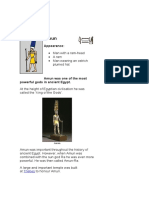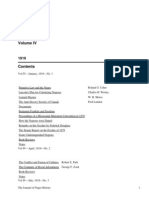Spirituality 08 PDF
Spirituality 08 PDF
Uploaded by
Francisco AscencioCopyright:
Available Formats
Spirituality 08 PDF
Spirituality 08 PDF
Uploaded by
Francisco AscencioOriginal Title
Copyright
Available Formats
Share this document
Did you find this document useful?
Is this content inappropriate?
Copyright:
Available Formats
Spirituality 08 PDF
Spirituality 08 PDF
Uploaded by
Francisco AscencioCopyright:
Available Formats
spirituality - lesson 8: ex libris
ex-libris by austin osman spare (left 1908, right 1909)
books are perceived as a vehicle to knowledge, coupled with the fact that in past times only a few people could read well, those in possession of books were seen as highly powerful individuals, with access to a level of reality that others didn't. monasteries and churches of every religion owned some of the biggest libraries, making them the primary sources of information and culture at the time. before the invention of the printing press the production of a single book was a long and difficult endeavor. the skin of sheep, goat or calve would have to be treated, stretched and dried, then cut and formed into sheets. a book like the bible might have taken over 200 hides to create the pages. scribes, a special few who were able write, would painstakingly transcribe the books, with elaborate details, then on top of that there was the craftsmanship of binding of the book. this whole arduous process meant that quite obviously books were expensive and libraries rare. even with the invention of paper in 750AD in china the accumulation of books in a library was an expensive business . 'to steal this book closes the gates of heaven, and to destroy it opens the gates of hell. anyone who takes this book without permission will be punished by all the gods of japan.' - an inscription on the book-seal of the daigoji temple, circa 1470. books are cherished and cared for. to academics and intellectuals books have always been of huge importance, not only for the knowledge they provide but also what theyr eflect about the owner. they are a source of pride and constant pleasure. there is something great about lending someone a book, sharing some knowledge, or simply entertainment with a friend, letting them participate in a treasured pleasure. but have you ever lent a book and never got it back? a common and annoying occurrence even today, but perhaps with less urgency than in the 14th century. as we have established, books were expensive and
therefore tempting objects to steal. one way to solve this was to chain them to tables, but another solution offered a far more interesting and creative opportunity. 'from the library of...' the earliest example of 'ex libris' is that of amenophis III in egypt. the small ceramic plate dates back to about 1390 AD, and would have been attached to papyrus scrolls declaring them to be a part of amenophis' library. however the origins of ex libris as we understand them today - in the form of paper bookplates - are found in germany during the 15th century and have a long history. these tokens of ownership were all hand painted onto small pieces of fine paper (a universal size that would fit all books) and then carefully pasted into them. of course, the arrival of the gutenberg printing press in 1455 changed everything. now people could create bigger libraries and with this there were more books to mark. having all the items decorated by hand would have been hugely costly therefore engraving and wood cut printed batches would be made and pasted into each volume, some being hand painted as well to enhance beauty. on paper thin enough so that the front cover can lay flat. batches of 50 to 100 each numbered and sighed by the artist.
by gregor rabinovitch circa 1910s
by emil d.j. doeple for wilheimi II circa 1895
by axel father, 1998
by peter fingesten for norbert nechwatal, 1984
by emil orlik for paul bacher, 1905
alois kolb for dr. gustav leuschner
blue glazed ceramic ex libris belonging the king amenophis III
by ye ling feng XI, 1933
by unknown for guan zu zhang, circa 1914
a universal ex libris, circa 1530
ex libris of hildebrand brandenburg of biberach, a monk in the monastery of buxheim. as a rich man, he donated many books to the monastery's library, circa 1790
by vogelmann, circa 1530
by jakob bink for carolus agricola, 1538
hand painted by jost ammann for melchior schedel, 1570 a later member of the family painted the first name over and substituted his own, sebastian,
by albrecht drer was one of the first noted ex libris artists in germany, 'sibi et amicis means belonging to him and his friends, circa 1500
by raphael sadeler for biblio bayern, circa 1623
by an unknown artist for sbastien galigai, circa 1610
by an unknown artist for pier huet, 1692. the most illustrious prince of the church gave the 8321 volumes of his book collection to the jesuit library in pari
ex-libris designed by samuel pepys for his secretary arthur charlett, 1699
by josef werner and elias hainzelmann for giovanni andrea guidotti, circa 1690
by sebastien le clerc & claude duflos for matthieu franois geoffory, circa 1710
by franois boucher for jean-franois henault, circa 1750
by george vertue for the gentlemen's society of spalding, england, 1735
a portrait ex libris by an unknown artist for count filippo linati, circa 1780
a portrait ex libris by bernard baron for a british architect james gibbs, 1736
by an unknown artist for paul and isaac vaillant, circa 1780
by max klinger for himself, 1896
surrealist image of a beheaded medusa by richard mller for leonhard fanto, 1911.
by louis titz for jules darcet, 1914 titz made several ex-libris in 1914-1918 on the subject of war, this ex libris has inscribed: 'in the ruins here was my library on the wall'
by juan forja for oscar tiberio, circa 1930 ex libris was not widespread argentina until the mid 1920's but the art dco style quickly arrived from europe
by alfred cossmann for himself, circa 1900
by alfred soder for friedrich berchtold sutter, 1907 nietsche naked in the alps, characteristic of the freedom and imagination of the time
by karl blossfeld for himself, circa 1920 blossfeld creates a figure representing man's frailty for his own books
ex libris of kasimir de rnay, circa 1925
by paul nash for samual courtauld, 1931
by author and playwright jean cocteau for pierre endmond lvy, 1960
by surrealist sculptor alberto giacometti for edmond bomsel, circa 1950
for the public record office in the tower of london, 1771
ex eroticis by fritz mock for dr. josef klber, circa 1910
ex eroticis by martin ernst phillipp for 'o.s.s', 1913
vanitas ex libris by johann jakob and johann rudolf schid, schmid
vanitas ex libris by josef sattler for paul bcher, 1894
vanitas ex libris by alfred liebing for joan baucis circa 1910
an example of vanitas ex libris, showing the medieval totentaz (dance of death) by karl ritter, 1921
a vanitas motif by georg oskar erler for his own bookplate, circa 1920
by erich bttner for albert einstein in 1917
ex libris for charlie chaplin
nerve cells for perrivel bailey, a neurosurgeon
by an unknown artist for scientist arthur barron
by an unknown artist for garrett hardin, a microbiologist
motifs the simplest way to indicate who owned a book was by the depiction of a coat of arms, or family crest. these types of identification symbols could be understood even by those who could not read, and were of course a proud way of communicating status. inscriptions and mottos were also popular, further reinforcing the views and beliefs of the book's owner. the earliest examples of ex libris are all heraldic in form. but like the technology of making books and ex libris evolved, so did the styles and motifs depicted on them. portraits soon became a popular alternative to family emblems, they provided a more individual and personal identification, and went someway to massaging egos! pictorial ex libris also was used to express the owners identity. throughout the age of enlightenment books became more and more widely available to people within different levels of society. the middle classes had increased access to culture and knowledge and as such they too began to form their own private libraries. not all these people, however could afford to commission an artist to create a personal ex libris, it was still an expensive collaborative process, reserved for the rich. engravers soon found that there was a market for universal bookplates, with which the owner could write their name in a blank space. later in the 18th and 19th centuries images and features such scales, shells, urns, architectural features landscapes, chinese motifs were prevalent in design. the overall effect having not so much to do with identification or heritage, as much as representation of values and interests. for example a pile of books may represent a neap of knowledge, or a microscope might represent a scientists work with small cells. by the early 20th century the designing and creating of ex libris became regarded as a form of high art. vanitas ex libris does not, as you might think, refer to the vain aspects of the ex libris tradition like pasting small depictions of oneself on all your literary possessions! instead it translates from latin 'vanitas' meaning emptiness, and is used to illustrate the meaningless of earthy life and the transient nature of vanity. very often symbols such as peacocks together with skulls and skeletons would be incorporated into the design, representing the finiteness of man and the certainty of death. as we've said before, it was during the middle ages in europe that librarianship really became popular. not only was this a time of unbounded exploration and discovery but also period of philosophical contemplation. death was prevalent due to diseases such as the black death / plague. the illustrations could be mistaken for references to the results of war, but instead they were a reminder that man is only mortal, a limited being with an expiry date. meanwhile books can last much longer and one day become the possessions of someone else. similarly an hourglass or candle might serve as a reminder of the transitory quality of pleasure. pictorial ex libris with books, globes, musical instruments or smoking implements dealt with the vanity of the intellectual world, coupled with a skull could mean the limitation of human knowledge. these small paper pieces remained as a sort of antique business card, marking
the intellectual property of learned people. is there a place for ex libris in the digital world? despite developments in modern communication technology, books remain a primary means for the transmission of knowledge but with the rise of the internet, and the freedom of acquiring knowledge that it brings with it, books have certainly lost their supremacy as the sole providers of knowledge and a lot of their followers. but even though books are not honoured in quite the same way more they have therefore referred back to their status of being special and uncommon. is there a digital equivalent of ex libris?
exercise
why not have a go at designing your own ex libris and post your efforts on the discussion board.
You might also like
- Ideo Method CardsDocument110 pagesIdeo Method CardsGao Yan90% (10)
- BBAW2103 Modiul BIDocument337 pagesBBAW2103 Modiul BIVignash50% (2)
- My Dear BB - . - The Letters of Bernard Berenson and KennetDocument601 pagesMy Dear BB - . - The Letters of Bernard Berenson and KennetLuis Antonio Espinoza CéspedesNo ratings yet
- Moorish Science Temple AmericaDocument9 pagesMoorish Science Temple AmericaAnthony Bonafide DakushNo ratings yet
- Black Wall StreetDocument4 pagesBlack Wall StreetJamahl ClevelandNo ratings yet
- Three Moves Ahead What Chess Can Teach You About BusinessDocument1 pageThree Moves Ahead What Chess Can Teach You About BusinessToshiba SatelliteNo ratings yet
- Benito Mussolini - The Manifesto of Race PDFDocument2 pagesBenito Mussolini - The Manifesto of Race PDFMani SadeghiNo ratings yet
- Mary Bruce Wallace Thinning of The Veil 1919Document114 pagesMary Bruce Wallace Thinning of The Veil 1919Vitor AngeloNo ratings yet
- PMD, A Registered Botanical Mosquito Repellent With Deet-Like Efficacy - PubMedDocument1 pagePMD, A Registered Botanical Mosquito Repellent With Deet-Like Efficacy - PubMedG TNo ratings yet
- A2 UNIT 1 Extra Grammar Practice ExtensionDocument1 pageA2 UNIT 1 Extra Grammar Practice ExtensionCarolinaNo ratings yet
- Axelaidtorootoft00lond BWDocument496 pagesAxelaidtorootoft00lond BWMarihHolas100% (1)
- Meteoric astronomy: A treatise on shooting-stars, fire-balls, and aerolitesFrom EverandMeteoric astronomy: A treatise on shooting-stars, fire-balls, and aerolitesNo ratings yet
- The Best Medicine in The World Is Right in Front of YouDocument41 pagesThe Best Medicine in The World Is Right in Front of YouDonya MaryaNo ratings yet
- Pushback Letter Supporting Catholic Exemptions - CficDocument4 pagesPushback Letter Supporting Catholic Exemptions - Cficapi-546862880No ratings yet
- Supernaturalizing Social Life: Religion and The Evolution of Human CooperationDocument55 pagesSupernaturalizing Social Life: Religion and The Evolution of Human Cooperationbmarks100% (1)
- CHRONOS by William HernDocument245 pagesCHRONOS by William HernWilliam HernNo ratings yet
- Your Miracle Power: Otker SpeakDocument12 pagesYour Miracle Power: Otker SpeakOnenessNo ratings yet
- Wwi Who Is To Blame DocumentsDocument7 pagesWwi Who Is To Blame Documentsapi-277818830No ratings yet
- CALIFORNIA MASONIC CODE - Masons of California PDFDocument287 pagesCALIFORNIA MASONIC CODE - Masons of California PDFJose F Vela RondonNo ratings yet
- 092 The Book of Constructive VirtuesDocument17 pages092 The Book of Constructive VirtuesImtiaz Muhsin100% (1)
- 1999 Testimony in Court Case by Chief Stephen Augustine - Fascinating Historical Information.Document184 pages1999 Testimony in Court Case by Chief Stephen Augustine - Fascinating Historical Information.Marie Daigle100% (1)
- Before The FezDocument39 pagesBefore The FezRodney A MuhammadNo ratings yet
- Hand On HeartDocument19 pagesHand On Heartbigwill35100% (1)
- The Magical and Ceremonial Uses of Fire (Folklore History Series)From EverandThe Magical and Ceremonial Uses of Fire (Folklore History Series)No ratings yet
- CanadaDocument86 pagesCanadasameergarg04No ratings yet
- The Fate of the Jews of Rzeszów 1939-1944 Chronicle of those daysFrom EverandThe Fate of the Jews of Rzeszów 1939-1944 Chronicle of those daysNo ratings yet
- Fuchs IntroductionDocument41 pagesFuchs IntroductiongiovanniglembajevicNo ratings yet
- Proclamation Announcement For The WORLD SERVICE AUTHORITYDocument4 pagesProclamation Announcement For The WORLD SERVICE AUTHORITY:Lawiy-Zodok:Shamu:-ElNo ratings yet
- An Alternate History of The United States of America-20190810-11707-P6orcoDocument17 pagesAn Alternate History of The United States of America-20190810-11707-P6orcoMoBique100% (1)
- United States v. Frank Church, Carl Louis Coppola, 955 F.2d 688, 11th Cir. (1992)Document24 pagesUnited States v. Frank Church, Carl Louis Coppola, 955 F.2d 688, 11th Cir. (1992)Scribd Government DocsNo ratings yet
- MeditationDocument4 pagesMeditationDennis MurphyNo ratings yet
- The Ruins by C. F. (Constantin Francois De) Volney (PDFDrive)Document209 pagesThe Ruins by C. F. (Constantin Francois De) Volney (PDFDrive)Yasmin ContrerasNo ratings yet
- A Reflection On Modern Science Zygon 14Document35 pagesA Reflection On Modern Science Zygon 14billy chrisNo ratings yet
- Moorish Guide-Seek Ye The Truth-2... 8!24!1928Document2 pagesMoorish Guide-Seek Ye The Truth-2... 8!24!1928Muhammed Al-ahari0% (1)
- Royal Commission On Aboriginal PeoplesDocument3,347 pagesRoyal Commission On Aboriginal PeoplesTessa VanderhartNo ratings yet
- Literary Land Claims: The “Indian Land Question” from Pontiac’s War to AttawapiskatFrom EverandLiterary Land Claims: The “Indian Land Question” from Pontiac’s War to AttawapiskatNo ratings yet
- Habeas Corpus Act 1679Document2 pagesHabeas Corpus Act 1679Jonathan Vélez-Bey100% (1)
- A Case For An Independent Sint Maarten.Document131 pagesA Case For An Independent Sint Maarten.Wade BaileyNo ratings yet
- EspDocument6 pagesEspRaven-100% (1)
- The Story of Geographical Discovery: How the World Became KnownFrom EverandThe Story of Geographical Discovery: How the World Became KnownNo ratings yet
- IsiXhosa HL P2 Feb-March 2016 PDFDocument28 pagesIsiXhosa HL P2 Feb-March 2016 PDFDalu KinzelaNo ratings yet
- Gods and GodessesDocument35 pagesGods and GodessesBrian de BeerNo ratings yet
- The Works of Robert G. Ingersoll, Vol. 5 (of 12) Dresden Edition—DiscussionsFrom EverandThe Works of Robert G. Ingersoll, Vol. 5 (of 12) Dresden Edition—DiscussionsNo ratings yet
- Constitutes ProactivenessDocument795 pagesConstitutes ProactivenessAndy Miguel CortezNo ratings yet
- Turkish CapitulationsDocument7 pagesTurkish Capitulationsrobnet-1No ratings yet
- 10 Secrets of The Old World Still Confusing To UsDocument7 pages10 Secrets of The Old World Still Confusing To UsMarija StankovicNo ratings yet
- Early American Indian DocsDocument2 pagesEarly American Indian DocsgeronimlNo ratings yet
- Pinson Mounds: Middle Woodland Ceremonialism in the MidsouthFrom EverandPinson Mounds: Middle Woodland Ceremonialism in the MidsouthNo ratings yet
- Westminster and The Civil Rights MovementDocument75 pagesWestminster and The Civil Rights Movementdavid_phs100% (1)
- Farrakhan (NOI) Responds To The Black HitlerDocument3 pagesFarrakhan (NOI) Responds To The Black HitlerRiff ShahNo ratings yet
- The Natural Moral Law and The CA Not N LawDocument71 pagesThe Natural Moral Law and The CA Not N LawHM King Benjamin IINo ratings yet
- Case of Proclamations 1611Document3 pagesCase of Proclamations 1611uday reddyNo ratings yet
- Conquistadors at Saltville in 1567Document22 pagesConquistadors at Saltville in 1567Alt Doom100% (1)
- IAMU PP Article IronWill - DR Joshua David StoneDocument11 pagesIAMU PP Article IronWill - DR Joshua David StoneSandile Lelaka100% (1)
- Moorish American Summer ProgramDocument2 pagesMoorish American Summer ProgramMalikBeyNo ratings yet
- Sheriff Mike Blakely Juror QuestionnaireDocument10 pagesSheriff Mike Blakely Juror QuestionnaireFOX54 News HuntsvilleNo ratings yet
- Lynch - OpinionDocument854 pagesLynch - OpinionCSTEPH1No ratings yet
- Reuben Swinburne Clymer - Wikipedia PDFDocument22 pagesReuben Swinburne Clymer - Wikipedia PDFLuz castro100% (1)
- Neter The Egyptian Word For God PDFDocument13 pagesNeter The Egyptian Word For God PDFDorianNo ratings yet
- The Journal of Negro History, Volume 4, 1919 by VariousDocument301 pagesThe Journal of Negro History, Volume 4, 1919 by VariousGutenberg.org100% (1)
- Umayyad Caliphs at DamascusDocument38 pagesUmayyad Caliphs at Damascusumesar001No ratings yet
- Spirituality - Lesson 30: Wall Clocks - Homework SubmissionsDocument18 pagesSpirituality - Lesson 30: Wall Clocks - Homework SubmissionsFrancisco AscencioNo ratings yet
- Spirituality 23 PDFDocument6 pagesSpirituality 23 PDFFrancisco AscencioNo ratings yet
- Spirituality 26 PDFDocument7 pagesSpirituality 26 PDFFrancisco AscencioNo ratings yet
- Spirituality 20 PDFDocument7 pagesSpirituality 20 PDFFrancisco AscencioNo ratings yet
- Spirituality 09 PDFDocument6 pagesSpirituality 09 PDFFrancisco AscencioNo ratings yet
- Spirituality 11 PDFDocument11 pagesSpirituality 11 PDFFrancisco AscencioNo ratings yet
- Spirituality 05 PDFDocument5 pagesSpirituality 05 PDFFrancisco AscencioNo ratings yet
- Spirituality 02 PDFDocument9 pagesSpirituality 02 PDFFrancisco AscencioNo ratings yet
- Spirituality 04 PDFDocument6 pagesSpirituality 04 PDFFrancisco AscencioNo ratings yet
- E2M Visualization enDocument32 pagesE2M Visualization enMarcelo Dias BezerraNo ratings yet
- Loveni: South AustraliaDocument21 pagesLoveni: South AustraliaSloveniaSANo ratings yet
- Abigail Phillips CVDocument16 pagesAbigail Phillips CVAbigail PhillipsNo ratings yet
- TA London GuideDocument8 pagesTA London GuideCAGMM100% (1)
- Zero Error Margin Complete Book 2003 Des Barker South Africa PDFDocument361 pagesZero Error Margin Complete Book 2003 Des Barker South Africa PDFtonydebruyn100% (2)
- C Programs On Pattern Printing Using Nested LoopDocument6 pagesC Programs On Pattern Printing Using Nested LoopncetcsedeptNo ratings yet
- Oracle Enterprise Manager Cloud Control 12c Advanced Configuration Workshop - D76687GC10 - 1080544 - USDocument3 pagesOracle Enterprise Manager Cloud Control 12c Advanced Configuration Workshop - D76687GC10 - 1080544 - USJinendraabhiNo ratings yet
- Luwig Prinn - de Vermis MysteriisDocument188 pagesLuwig Prinn - de Vermis MysteriisMateus Saraiva100% (3)
- The Museum of Modern Art: A Century of Artists BooksDocument5 pagesThe Museum of Modern Art: A Century of Artists BooksnoizfilesNo ratings yet
- Banking SystemDocument46 pagesBanking SystemTejpal Singh100% (2)
- Oscar NiemeyerDocument4 pagesOscar Niemeyerlexishi ShiNo ratings yet
- Project Report Library Management SystemDocument24 pagesProject Report Library Management Systempriya manchu100% (3)
- Reference Format DictionaryDocument6 pagesReference Format Dictionaryfzdpofajd100% (2)
- Education SocietyDocument16 pagesEducation SocietykiranNo ratings yet
- Library & Information-Science-APSC SYLLABUSDocument5 pagesLibrary & Information-Science-APSC SYLLABUSsriparna241395No ratings yet
- The Copper Hoards of The Indian Subcontinent Preliminaries For An Interpretation (Paul Yule, 1989)Document85 pagesThe Copper Hoards of The Indian Subcontinent Preliminaries For An Interpretation (Paul Yule, 1989)Srini Kalyanaraman100% (3)
- Necromancy in The Medici Library An Edition and Translation of Excerpts From Biblioteca Medicea Laurenziana, MS Plut. 89 Sup.... (Brian Johnson) (Z-Library)Document153 pagesNecromancy in The Medici Library An Edition and Translation of Excerpts From Biblioteca Medicea Laurenziana, MS Plut. 89 Sup.... (Brian Johnson) (Z-Library)marcinbueno95No ratings yet
- The Project Gutenberg Ebook, Arts and Crafts in The Middle Ages, by Julia de Wolf AddisonDocument207 pagesThe Project Gutenberg Ebook, Arts and Crafts in The Middle Ages, by Julia de Wolf AddisonGutenberg.org100% (1)
- Using ODBC: ContextDocument16 pagesUsing ODBC: ContextGilberto Garcia ZavaletaNo ratings yet
- Library Guide: Dedan Kimathi University of TechnologyDocument2 pagesLibrary Guide: Dedan Kimathi University of TechnologyRando ClintonNo ratings yet
- IELTS Writing Task 1 - Bài Mẫu IELTS FighterDocument39 pagesIELTS Writing Task 1 - Bài Mẫu IELTS FighterThùyy VyNo ratings yet
- From Washington To Moscow by Louis SellDocument15 pagesFrom Washington To Moscow by Louis SellDuke University PressNo ratings yet
- Pronounce It Perfectly in English (PDFDrive)Document104 pagesPronounce It Perfectly in English (PDFDrive)Brandon Valentine0% (1)
- London Show Daily 17 April 2012Document36 pagesLondon Show Daily 17 April 2012Publishers WeeklyNo ratings yet
- Philippine Sungka and Cultural ContactDocument10 pagesPhilippine Sungka and Cultural ContactrhgnicanorNo ratings yet
- Maven RC NotesDocument6 pagesMaven RC NotessxurdcNo ratings yet



































































































